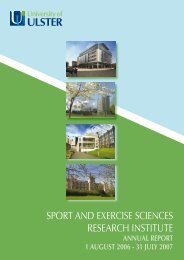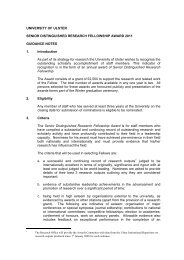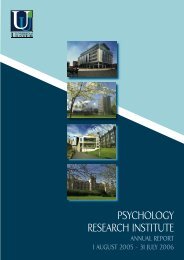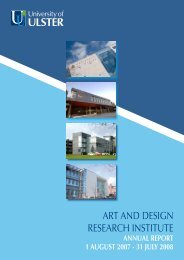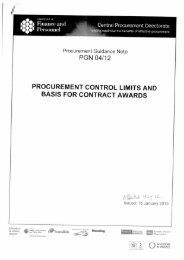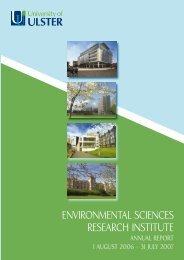Dr Raymond BeirneLecturer in OptometryContact details:T: +44 (0)28 70324477r.beirne@ulster.ac.ukDr Beirne’s <strong>research</strong> interests are in pure and applied human visual psychophysics, ocular ageing and ocular disease.He has been involved in a variety <strong>of</strong> laboratory-based and clinical studies <strong>of</strong> human visual function which havefocused on the normal short-wavelength visual system, how it is affected by age and the changes that can occur inthe ocular diseases <strong>of</strong> glaucoma and age-related macular degeneration.The Farnsworth-Munsell 100 hue test.In particular, he has examined the structure-function relationship between short-wavelength acuity and the neurallimits to vision imposed by the retinal anatomy. The aims <strong>of</strong> Dr Beirne’s <strong>research</strong> are to gain a better understanding<strong>of</strong> how visual function changes with age, the impact this has on the observer and the effect ocular disease has onvisual function. The ability to develop novel measures <strong>of</strong> visual function in ocular disease, which better identifydisease and progression earlier than traditional methods is an ultimate goal. Dr Beirne was included in the <strong>University</strong><strong>of</strong> <strong>Ulster</strong> submission to the 2008 <strong>Research</strong> Assessment Exercise, UoA 12.Publications:Beirne RO, McIlreavy L & Zlatkova MB; The effect <strong>of</strong> lens yellowing on Farnsworth-Munsell 100 hue error score;Ophthalmic and Physiological Optics, 28: 448-456, 2008Beirne RO, Zlatkova MB, Chang CK, Chakravarthy U & Anderson RS; How does the short-wavelength-sensitivecontrast sensitivity function for detection and resolution change with age in the periphery? Vision <strong>Research</strong>, 48: 1894-1901, 2008AbstractsBeirn RO, Hogg RE, Stevenson MR, Anderson RS & Chakravarthy U; Visual function, age-related maculopathy stageand the subsequent development <strong>of</strong> age-related macular degeneration; Investigative Ophthalmology and Visual Science,49: ARVO E- abstract 2894, 2008Beirne RO, McIlreavy L, Gore S & Zlatkova MB; Age-related lens yellowing per se contributes little to the increase inFarnsworth-Munsell 100 hue error scores with age; Ophthalmic and Physiological Optics, 28: 96. 2008116
Dr Jan LauritzenLecturer in OptometryDr Lauritzen’s <strong>research</strong> focuses on human psychophysics <strong>of</strong> early visual processes in the retina, primary visual cortexand extrastriate areas, and computer modelling <strong>of</strong> those processes. In collaborations, Dr Lauritzen also has a widermultidisciplinary interest in computer modelling <strong>of</strong> physiological processes in general and the design <strong>of</strong> psychophysicalprotocols for sensory physiology and experimental psychology.Computer modelling:An array <strong>of</strong> model receptivefields used to represent simplecells in V1The early steps in vision are mediated by cells with relatively simple receptive fieldsthat have been well described. However, computer models using such receptive fieldsnevertheless provide poor predictions <strong>of</strong> psychophysical performance in tasks thoughtto be mediated exclusively or predominantly in the retina and primary visual cortex (V1),especially when the test image is complex, such as a natural image. Computer modelling<strong>of</strong> the connections between cells in V1 involved in contrast gain control mechanisms andresponses from outside the classical receptive field has been used to improve prediction<strong>of</strong> psychophysical results in contrast discrimination tasks involving natural images.A similar computer model has also been used to demonstrate that contrast gain controlcan adequately account for differences in the contrast in natural images produced bydifferent lighting conditions (diffuse and direct), thus providing a form <strong>of</strong> ‘contrastconstancy’.Example <strong>of</strong> an image pair <strong>of</strong> foliage taken in direct light (left) and diffuse illumination (right). A model <strong>of</strong> contrastnormalisation virtually eliminates the differences between the two images.Human psychophysicsContrast discrimination tasks, where human observers are detect a simple contrast stimulus before a maskingbackground, provide well-understood, predictable thresholds when the mask is also simple. However as the maskbecomes more complex, thresholds become rapidly less predictable, and for natural or pseudo-natural images resultscan be counter-intuitive. For example, masking experiments on natural images have shown that, when an image isfiltered to remove the contrast that should optimally mask a particular contrast channel, thresholds <strong>of</strong>ten increase(i.e. the task becomes harder). Intracortical interactions are thought responsible, and computer models are beingused to determine the nature <strong>of</strong> these interactions, in view <strong>of</strong> predicting psychophysical thresholds correctly fordifferent types <strong>of</strong> stimuli with a single model.117
- Page 1:
BIOMEDICAL SCIENCESRESEARCH INSTITU
- Page 4 and 5:
1 Foreword by the Pro Vice-Chancell
- Page 6 and 7:
2 Foreword by the Research Institut
- Page 8 and 9:
The BMSRI Research StructureThe BMS
- Page 10 and 11:
BMSRI Core FacilitiesContact: Karen
- Page 12 and 13:
of Metabolomics, pharmacy, nutritio
- Page 14 and 15:
BMSRI Academic Heads new Regional N
- Page 16 and 17:
4. BIOMEDICAL GENOMICS RESEARCH GRO
- Page 18 and 19:
Recent Funding Initiatives:C-TRIC:
- Page 20 and 21:
Dr Mateus Webba da SilvaLecturer in
- Page 22 and 23:
5. BIOIMAGING RESEARCH GROUPResearc
- Page 24 and 25:
developmental alterations that mani
- Page 26 and 27:
Publications:Bigot S, Lucas L, Morr
- Page 28 and 29:
Publications:Barnes CA, O’Hagan B
- Page 30 and 31:
We also measure the genotoxic effec
- Page 32 and 33:
6. CANCER AND AGEING RESEARCH GROUP
- Page 34 and 35:
Professor Anthony P McHaleProfessor
- Page 36 and 37:
Professor Stephanie McKeownProfesso
- Page 38 and 39:
an Alzheimer Research Trust collabo
- Page 40 and 41:
JM, Waugh DJJ; Dexamethasone potent
- Page 42 and 43:
have wider applications in vivo, in
- Page 44 and 45:
Inter-relationships between diet an
- Page 46 and 47:
Flatt PR; Effective surgical treatm
- Page 48 and 49:
These areas are the subject of seve
- Page 50 and 51:
Dr YHA Abdel-WahabSenior Lecturer i
- Page 52 and 53:
Dr VA GaultLecturer in Molecular Bi
- Page 54 and 55:
McClean PL, Irwin N, Hunter K, Gaul
- Page 56 and 57:
Publications:Duffy NA, Green BD, Ir
- Page 58 and 59:
8. MICROBIOLOGY AND BIOTECHNOLOGYRE
- Page 60 and 61:
Publications:Graham RJL, Graham C,
- Page 62 and 63:
analyses. However there is still a
- Page 64 and 65:
Plessas S, Bekatorou A, Koutinas AA
- Page 66 and 67:
Biochemical studies/ viral evasion
- Page 68 and 69: Dr Stephen McCleanLecturer in Prote
- Page 70 and 71: environmental remediation and as ro
- Page 72 and 73: 9. NORTHERN IRELAND CENTRE FOR FOOD
- Page 74 and 75: 26-28 Sept 2007: International Seaf
- Page 76 and 77: Dr Barnes has developed expertise i
- Page 78 and 79: Dr Alison GallagherSenior Lecturer
- Page 80 and 81: In addition, results of a pilot stu
- Page 82 and 83: Dr Maeve KerrResearch AssociateCont
- Page 84 and 85: Memberships of External Committees/
- Page 86 and 87: Indicators of Esteem:Professor McNu
- Page 88 and 89: were examined. The intervention and
- Page 90 and 91: Within this work both short-term an
- Page 92 and 93: micronutrient supplementation at a
- Page 94 and 95: 10. STEM CELL & EPIGENETICS RESEARC
- Page 96 and 97: Publications:Lees-Murdock DJ, Lau H
- Page 98 and 99: Publications:Lees-Murdock DJ, Lau H
- Page 100 and 101: 11. SYSTEMS BIOLOGY RESEARCH GROUPT
- Page 102 and 103: Kravtsov V, Swain M, Schuster A, Du
- Page 104 and 105: Dr Daniel BerrarLecturer in Biomedi
- Page 106 and 107: Zhang et al; Incorporating Feature
- Page 108 and 109: Bala P, Baldridge K, Benfenati E, C
- Page 110 and 111: In addition there is a growing them
- Page 112 and 113: Clinical work involves development
- Page 114 and 115: In 2009 he was appointed Chairman o
- Page 116 and 117: Stevenson TR, Goodall EA and Moore
- Page 120 and 121: Dr Julie McClellandLecturer in Opto
- Page 122 and 123: Graham JE, Moore JE, Moore JE, McCl
- Page 124 and 125: Research Staff:Dr David OrrSenior R
- Page 126 and 127: Dr Victoria McGilliganResearch Asso
- Page 128 and 129: 13. Externally Funded Projects duri
- Page 130 and 131: Grant Holder Anderson, Prof RSFundi
- Page 132 and 133: Funding Body Royal Irish AcademyAmo
- Page 134 and 135: 14. BIOMEDICAL SCIENCES RESEARCH IN
- Page 136 and 137: Student: Simon GenglerTitle: Effect
- Page 138 and 139: Student: Anisha MazumdarTitle: Anal
- Page 140 and 141: Student: Clare RyanTitle: How does
- Page 142 and 143: CONGRATULATIONS TO THE FOLLOWING PO






